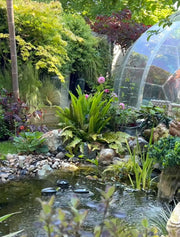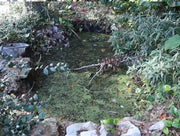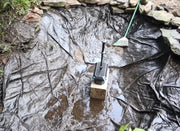Planning to Build a Pond
Where To Start
Building a pond can seem like a big DIY project to take on, but it doesn’t have to be complicated. Prevent common pitfalls and start your project the right way. It all starts with a good plan!
Step 1: Before The Build

Safety
- Before digging, contact your local utility service to avoid damaging underground pipes or cables.
- Visit Call 811 or dial 811 for assistance.
Pond Location
Choosing the right location for your pond is a crucial step in the pond building process. It will affect water quality, plant growth, and the overall aesthetics of the pond. Here are a few key points to consider when selecting a pond location:

Sunlight Exposure
Ensure that your pond receives adequate sunlight. Ideally, the pond should get 4 to 6 hours of sunlight per day. Sunlight helps promote plant growth and maintains oxygen levels in the water. However, avoid placing your pond in full sun all day, as it could lead to high water temperatures and excessive algae growth.
Avoid Windy Areas
Avoid placing your pond in a windy area. Strong winds can increase evaporation rates and cause water level fluctuations. Winds can also bring in leaves and debris, making pond maintenance more challenging.
Avoid Trees and Large Plants
Building a pond near trees can lead to an abundance of falling leaves, which can degrade water quality and increase the maintenance workload. Large trees with extensive roots may also interfere with the pond's structure.
Low-lying Areas
The best location is typically a low-lying area, as it helps avoid water runoff during heavy rains. A lower area can help stabilize water levels and reduce drainage problems.
Ease of Installation and Maintenance
Choose a location that is easy to access for installation and regular maintenance. Your pond should be easily reachable for routine checks, cleaning, and equipment maintenance.
Elevation
Your pond should be built on level ground. If it is placed on a slope, ensure that water runoff does not carry soil into the pond.


Sunlight
Aquatic plants in your pond require sufficient sunlight. If you plan to add plants, choose a location with at least 4-6 hours of sunlight per day.
Integration
The size, scale, and layout of your pond should complement the other features of your yard, including your landscaping and terrain. Here are some key considerations to help you choose the right pond layout and shape:

Choose the Size and Shape of Your Pond
You can determine the size and shape of your pond based on your preference and landscaping. Use rope or spray paint to mark the shape and see what works best in your space.
Consider Water Features
Think about any additional water features you'd like to add, such as fountains, spitters, or potential add-ons like waterfalls. Consider how they will fit into the pond shape.
Pond Liner Selection
Pond liners are typically rectangular, so it’s recommended to choose a shape that fits within a rectangle. Common pond shapes include ellipse, kidney, pear, and freeform. Be sure to choose a liner that fits your pond size, and keep in mind that the recommended pond depth is a minimum of 1.5 ft, with up to 3 ft for koi ponds.
Step 2: Time to Dig!
Once you’ve chosen the perfect spot, mark the area with rope or spray paint, then start digging!

Digging Tips:
✔ Start shallow, then deepen sections for plants or fish – Depth should be at least 1.5 ft for plants and 2-3 ft for fish ponds.
✔ Shape edges for stability – Consider adding a plant shelf around the pond for extra support.
TIP: For koi ponds in colder climates, a 3+ ft depth helps maintain water temperature during winter.
Step 3: Know The Volome of Your Pond

Use Our Calculator
Before choosing your pond pump, it’s essential to know the volume of water your pond will hold. Use the following formula:
Pond Volume Formula:
Pond Volume (Gallons) = Length (ft) × Width (ft) × Avg Depth (ft) × 7.48 × 0.8
Sizing Guide:
Small ponds – Up to 200 gallons
Medium ponds – Up to 600 gallons
Large ponds – Over 1,000 gallons
TIP: If you prefer a no-dig option, consider above-ground ponds.
Select Your Products
Now that you’ve dug the hole and know your new pond’s size, it’s time to select your products!








